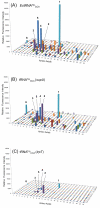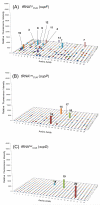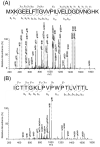Exploring the substrate range of wild-type aminoacyl-tRNA synthetases
- PMID: 24890918
- PMCID: PMC4133344
- DOI: 10.1002/cbic.201402083
Exploring the substrate range of wild-type aminoacyl-tRNA synthetases
Abstract
We tested the substrate range of four wild-type E. coli aminoacyl-tRNA synthetases (AARSs) with a library of nonstandard amino acids (nsAAs). Although these AARSs could discriminate efficiently against the other canonical amino acids, they were able to use many nsAAs as substrates. Our results also show that E. coli tryptophanyl-tRNA synthetase (TrpRS) and tyrosyl-tRNA synthetase have overlapping substrate ranges. In addition, we found that the nature of the anticodon sequence of tRNA(Trp) altered the nsAA substrate range of TrpRS; this implies that the sequence of the anticodon affects the TrpRS amino acid binding pocket. These results highlight again that inherent AARS polyspecificity will be a major challenge in the aim of incorporating multiple different amino acids site-specifically into proteins.
Keywords: aminoacyl-tRNA synthetases; natural nonsense tRNA suppressors; nonstandard amino acids; substrate specificity; synthetic biology; tRNA.
© 2014 WILEY-VCH Verlag GmbH & Co. KGaA, Weinheim.
Figures




Similar articles
-
Anticodon recognition in evolution: switching tRNA specificity of an aminoacyl-tRNA synthetase by site-directed peptide transplantation.J Biol Chem. 2003 Aug 15;278(33):30927-35. doi: 10.1074/jbc.M302618200. Epub 2003 May 22. J Biol Chem. 2003. PMID: 12766171
-
Non-canonical Amino Acid Substrates of E. coli Aminoacyl-tRNA Synthetases.Chembiochem. 2022 Jan 5;23(1):e202100299. doi: 10.1002/cbic.202100299. Epub 2021 Sep 22. Chembiochem. 2022. PMID: 34416067 Free PMC article. Review.
-
An evolved aminoacyl-tRNA synthetase with atypical polysubstrate specificity.Biochemistry. 2011 Mar 22;50(11):1894-900. doi: 10.1021/bi101929e. Epub 2011 Feb 1. Biochemistry. 2011. PMID: 21280675 Free PMC article.
-
Importance of single molecular determinants in the fidelity of expanded genetic codes.Proc Natl Acad Sci U S A. 2011 Jan 25;108(4):1320-5. doi: 10.1073/pnas.1012276108. Epub 2011 Jan 11. Proc Natl Acad Sci U S A. 2011. PMID: 21224416 Free PMC article.
-
Substrate selection by aminoacyl-tRNA synthetases.Nucleic Acids Symp Ser. 1995;(33):40-2. Nucleic Acids Symp Ser. 1995. PMID: 8643392 Review.
Cited by
-
Engineering aminoacyl-tRNA synthetases for use in synthetic biology.Enzymes. 2020;48:351-395. doi: 10.1016/bs.enz.2020.06.004. Epub 2020 Sep 8. Enzymes. 2020. PMID: 33837709 Free PMC article.
-
Plasticity and Constraints of tRNA Aminoacylation Define Directed Evolution of Aminoacyl-tRNA Synthetases.Int J Mol Sci. 2019 May 9;20(9):2294. doi: 10.3390/ijms20092294. Int J Mol Sci. 2019. PMID: 31075874 Free PMC article. Review.
-
Engineering posttranslational proofreading to discriminate nonstandard amino acids.Proc Natl Acad Sci U S A. 2018 Jan 16;115(3):619-624. doi: 10.1073/pnas.1715137115. Epub 2018 Jan 4. Proc Natl Acad Sci U S A. 2018. PMID: 29301968 Free PMC article.
-
Rewiring protein synthesis: From natural to synthetic amino acids.Biochim Biophys Acta Gen Subj. 2017 Nov;1861(11 Pt B):3024-3029. doi: 10.1016/j.bbagen.2017.01.014. Epub 2017 Jan 15. Biochim Biophys Acta Gen Subj. 2017. PMID: 28095316 Free PMC article. Review.
-
tRNA shape is an identity element for an archaeal pyrrolysyl-tRNA synthetase from the human gut.Nucleic Acids Res. 2024 Jan 25;52(2):513-524. doi: 10.1093/nar/gkad1188. Nucleic Acids Res. 2024. PMID: 38100361 Free PMC article.
References
-
- Richmond MH. Bacteriol Rev. 1962;26:398–420. - PMC - PubMed
- Xu ZJ, Love ML, Ma LY, Blum M, Bronskill PM, Bernstein J, Grey AA, Hofmann T, Camerman N, Wong JT. J Biol Chem. 1989;264:4304–4311. - PubMed
- Li L, Boniecki MT, Jaffe JD, Imai BS, Yau PM, Luthey-Schulten ZA, Martinis SA. Proc Natl Acad Sci USA. 2011;108:9378–9383. - PMC - PubMed
-
- Kavran JM, Gundllapalli S, O’Donoghue P, Englert M, Söll D, Steitz TA. Proc Natl Acad Sci U S A. 2007;104:11268–11273. - PMC - PubMed
- Ko JH, Wang YS, Nakamura A, Guo LT, Söll D, Umehara T. FEBS Lett. 2013;587:3243–3248. - PMC - PubMed
- Nguyen DP, Lusic H, Neumann H, Kapadnis PB, Deiters A, Chin JW. J Am Chem Soc. 2009;131:8720–8721. - PubMed
- Takimoto JK, Dellas N, Noel JP, Wang L. ACS Chem Biol. 2011;6:733–743. - PMC - PubMed
- Wang YS, Fang X, Chen HY, Wu B, Wang ZU, Hilty C, Liu WR. ACS Chem Biol. 2013;8:405–415. - PMC - PubMed
- Wang YS, Fang X, Wallace AL, Wu B, Liu WR. J Am Chem Soc. 2012;134:2950–2953. - PMC - PubMed
- Wang YS, Russell WK, Wang Z, Wan W, Dodd LE, Pai PJ, Russell DH, Liu WR. Mol Biosyst. 2011;7:714–717. - PubMed
- Yanagisawa T, Ishii R, Fukunaga R, Kobayashi T, Sakamoto K, Yokoyama S. Chem Biol. 2008;15:1187–1197. - PubMed
- Young DD, Young TS, Jahnz M, Ahmad I, Spraggon G, Schultz PG. Biochemistry. 2011;50:1894–1900. - PMC - PubMed
- Wang ZU, Wang YS, Pai PJ, Russell WK, Russell DH, Liu WR. Biochemistry. 2012;51:5232–5234. - PMC - PubMed
- Wang YS, Wu B, Wang Z, Huang Y, Wan W, Russell WK, Pai PJ, Moe YN, Russell DH, Liu WR. Mol Biosyst. 2010;6:1557–1560. - PubMed
- Fekner T, Li X, Lee MM, Chan MK. Angew Chem Int Ed Engl. 2009;48:1633–1635. - PubMed
Publication types
MeSH terms
Substances
Grants and funding
LinkOut - more resources
Full Text Sources
Other Literature Sources
Molecular Biology Databases
Miscellaneous

